Australian Audio and AV Show 2012
The Australian Audio and AV Show. Held in Sydney this year, the first audio show in Sydney in over two decades. Definitely not something to be missed by a local audiophile. After Paul Spencer’s report on last year’s show held in Melbourne, I was keen to meet and see the Australian manufacturers in particular, but also to see what else was on offer in retail hifi. As a student, I used to wander along York and Clarence Streets in the city popping into the hifi stores there to check out what I couldn’t possibly afford. But high-end B&M stores are fewer and farther between these days, so what better place to go than three floors of the Sheraton packed with gear?
I was only able to spend a day and a half at the show, and so missed a lot of rooms. On the Saturday, you had to be lucky to get into some rooms, so a few that I wanted to hear got missed that way. Rather than simply try and catalogue all the rooms, this is more of a personal tour of the show, with the things that I found interesting.
Greg Osborn of Osborn Loudspeakers had his rather large lead-lined Grand Monument Reference playing when I first went to his room. I went back to try and have a listen with my own CD the following day, but they had been moved aside, as Greg felt that people would be more interested in the smaller, more affordable speakers he had on offer.
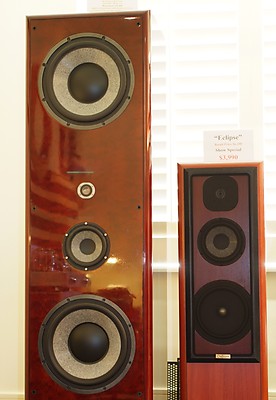
Osborn Grand Monument Reference and Eclipse loudspeakers
I asked Greg about toe-in, as his speakers were all positioned pointing straight ahead. I always (out of habit now as much as anything) toe in speakers to point in front of me. Greg’s response is that the dispersion of his speakers is sufficiently wide that toe-in is not required to achieve a stable soundstage.
Greg also had a large rack packed with heavy-looking tube amplifiers, which Greg imports and sells. He initially bought some for himself, and people asked him about getting them, so he decided to make part of his business too. All of the amps were powered on all the time, giving the room’s air-conditioning a bit of a workout.
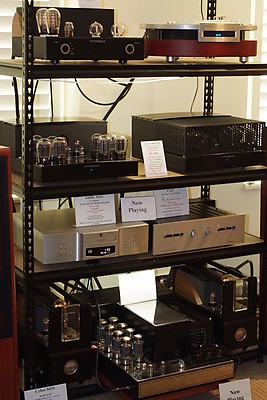
Rack of amps in the Osborn room
Further down the hall, a completely different type of speaker caught my eye. The Brodmann Acoustics room had a small pair of standmount speakers playing when I walked in. These are unusual in that the tweeter is the only driver located on the front of the speaker, and the woofer is on the side of the cabinet. I asked about the dispersion pattern, a question they were apparently used to fielding, and was told that no, the frequency response is very uniform. Certainly, the smaller speakers (they were playing classical when I came in) sounded very natural, albeit of course without a lot of bass. The speakers are made by the same Viennese company that makes pianos, and the beautiful finish on the speakers certainly reflected that heritage. Brodmann is currently seeking Australian distribution, so if you’ve had a hankering to get into the audio business, here’s your chance.
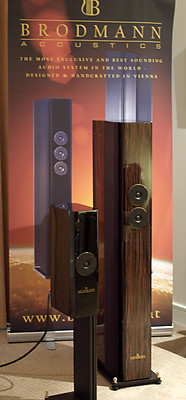
Brodmann Acoustics
In the realm of “curious” was this pair of glass speakers, the Niagara from Waterfall Speakers.
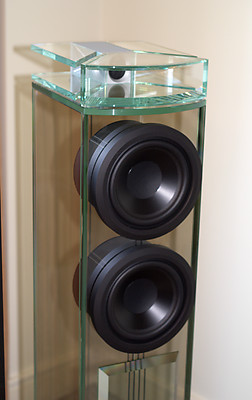
Waterfall glass speakers
The Hansen Audio Prince E, with its rear-firing tweeter, provided a good example of the importance of room setup. Despite the pedigree of the speakers and the Avid Hifi vinyl source, I thought they sounded overly bright and aggressive in that room. Perhaps they improved on subsequent days of the show.
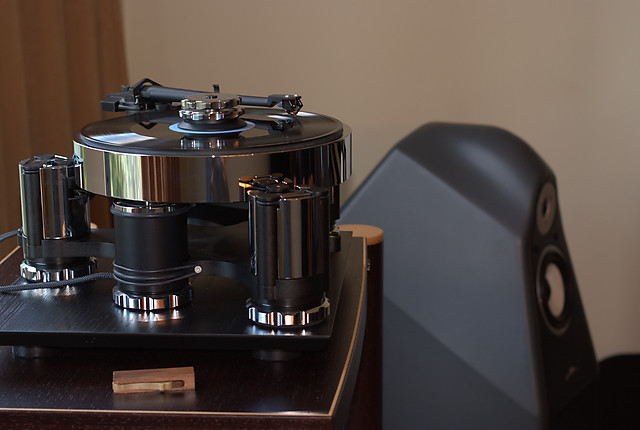
A refreshing change met me down the end of the hall, in what must have been the smallest room in the hotel! Equinox Audio, located on the outskirts of Sydney, brought just one pair of loudspeakers, their small Eclipse loudspeaker. Rick Stadlmeier obviously believes in matching the loudspeaker to the room, and you’ll see from their speaker page that room size is a key criterion in determining which speaker in their range is suitable for you. The Eclipse is a sealed design, with low-frequency extension to about 55 Hz. Equinox was one of the few companies at the show that made any effort at acoustic treatment.
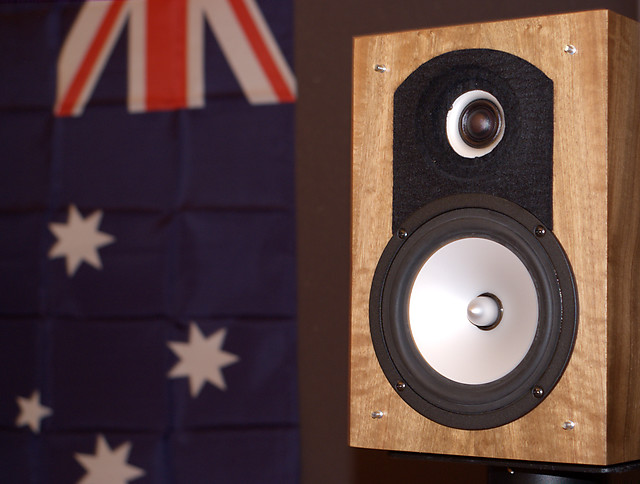
Equinox Audio Eclipse
Speaking of acoustic treatment, I was intrigued to notice these panels in the Yamaha room. The panels are quite thin, and the Yamaha person there claimed that they are Helmholtz resonators. More detail on the Yamaha site, which shows a much more uniform absorption with respect to frequency than typical fibreglass absorbers.I believe they are about $400 each. An intriguing product that is worth learning more about.
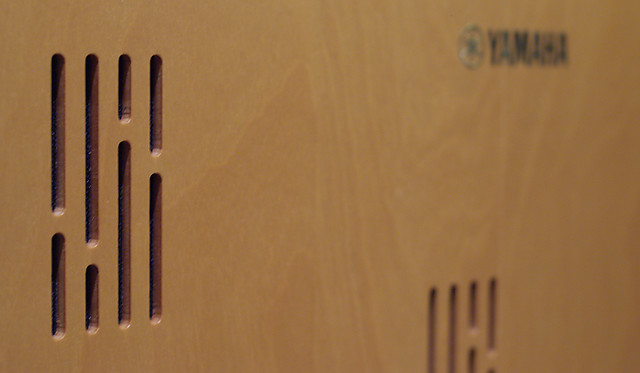
Yamaha Acoustic Conditioning Panel
The speaker playing in the room was the Yamaha Soavo-1. I did listen to it briefly before being driven out of the room by the chatter of the salespeople behind me, but from what I could hear, it sounded quite nice.
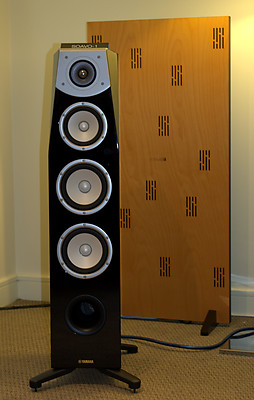
Yamaha Acoustic Conditioning Panels and Soavo-1 speaker
I am a bit of a fan of dipole (panel or open-baffle) speakers, and was pleased to hear the smaller of the Analysis Audio models, the Omicron. And not just because they are red. I really liked the sound in this room, despite the necessity of being placed close to the wall and with a lot of glass behind them, although a couple of others commented that they thought it a bit bright. I’d love to hear them with a more optimal placement. This model retails for about $13,000.
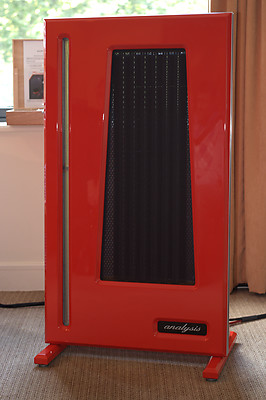
Analysis Audio Omicron
Back to the Australian manufacturers, Philip Vafiadis of VAF Research demonstrated his line of speakers with style and verve, explaining that the design philosophy of the company carries across all models, from the smallest to largest.
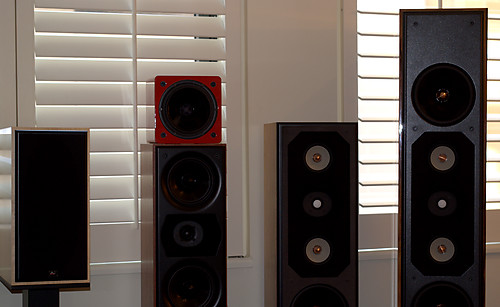
VAF Speaker lineup at the Sydney Audio and AV show
When I walked in, the small coaxial Signature i90s were playing. At a grand per unit, my impressions were that they would, together with a sub, make a great starter system or a system for a smaller room. Five would be killer for HT. Especially in red.
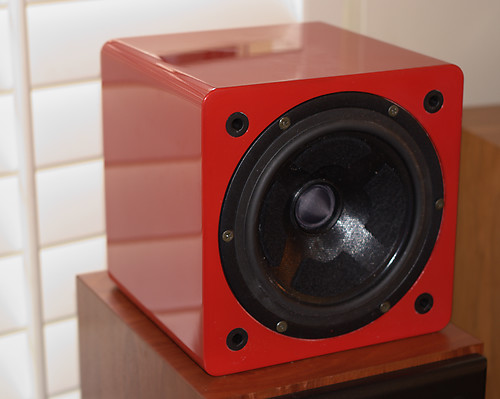
VAF Signature i90
Phil also had an even smaller speaker on show, the i49. Phil explained that VAF had taken what they had learnt with the i90 and wanted to see how far they could go with the concept. These retail for $599 each.
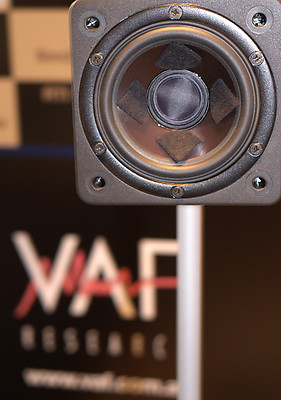
VAF Signature i49 compact speaker
Finn Bespoke in Sydney has taken up distributorship of Audio Note products. I popped into their room at the very beginning of day 2 but didn’t stop for a listen as I was in a hurry to get to the Kyron room before the crowds. Unfortunately I never managed to make it back. Auditions by appointment in their Dee Why showroom.
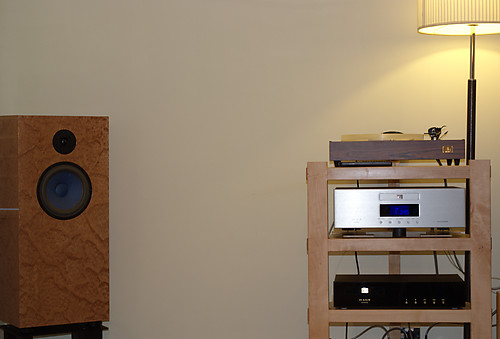
The Audio Note room at the Sydney Audio and AV show
I did very much enjoy casting my eye over the old-school construction techniques of some of the gear though:
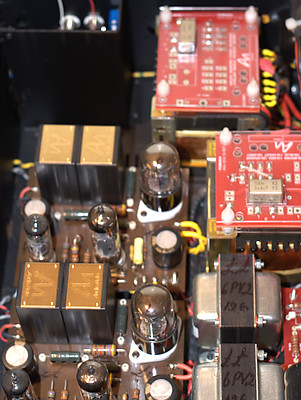
Old-school construction technique inside Audio Note gear
Now, on to the Kyron Audio room, where the Gaia was warming up for the day. I am glad I got in early, as the room was packed an hour later – and justifiably so. The Gaia presented everything thrown at it effortlessly, despite the limitations of the room. The front wall had some treatment, and Leon Suter from Kyron told me that while they had spent a couple of hours adjusting the Gaia’s DEQX-based crossover unit to optimize it as best they could for the room, there were still some issues that couldn’t be tamed.
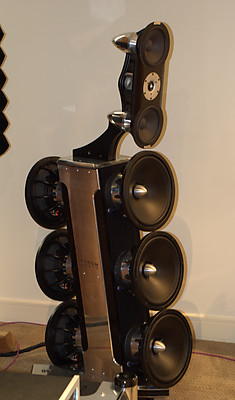
Kyron Audio Gaia at the Sydney Audio and AV Show
The Gaia is an open baffle speaker… with no baffle. Leon explained that over the years they had experimented with various baffles, but always found that some baffle resonance was bringing back some of the “box sound” that they were trying to eliminate. And by the time the baffle was thick enough to remove all resonances, the thickness of it would create a tunnel resonance in the driver cavity that was, again, audible. The end result: no baffle, with enough bass drivers mounted on a massive machined metal beam to produce the required high levels of bass output.
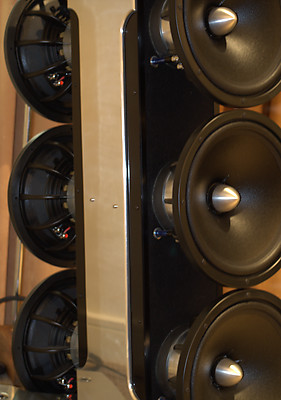
Kyron Audio Gaia, woofer section
The mids and highs on the Gaia are handled by Scan-speak drivers, with two mids, and back-to-back ring radiator tweeters to continue the dipole radiation up past the audible range. For shipping, the mid/tweeter module detaches from the bass column.
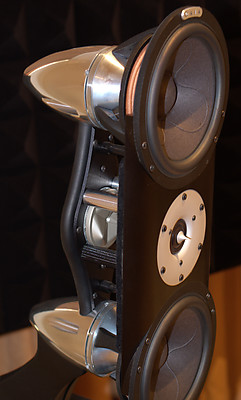
Kyron Audio Gaia mid and tweeter module
All of the electronics are housed in a small “fridge” – the DEQX crossover/preamp, 8 channels of Hypex-based class-D amplification, and associated power supplies. All that’s required is a source, either by analog or digital input.
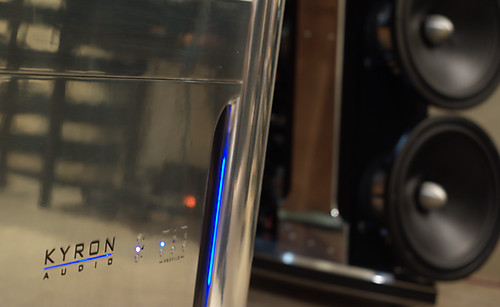
Kyron Audio Gaia electronics unit
Easily the best sound of the show, the Kyron Gaia is an impressive showing from a young Australian venture, a genuine tour de force of loudspeaker technology and engineering. It’s not the kind of thing that you will unpack at home and plonk down in your room – Kyron include two days of installation, setup, and tuning in the price. At $188,000, you may have to put your plans for a new Ferrari on hold for a little while, but consider also that all of the electronics (except source) are included and the system is fine-tuned to work in your room from day 1. Leon hinted that there may be some “trickle down” technology into a smaller model, but no information is available yet.
After the Gaia, everything else was going to have a hard time making much of an impression. I’m breathless just writing about it. But back in reality, the room across the hallway housed an intimate gathering (the same small room as Equinox, but a level above), admiring the new ML2 Reference from Lenehan Audio on the Gold Coast. Mike Lenehan commented that the ML2s did need a bigger room. The ML2 is available in three “trim” levels, from the $4,500 standard model up to the $6,900 Reference.
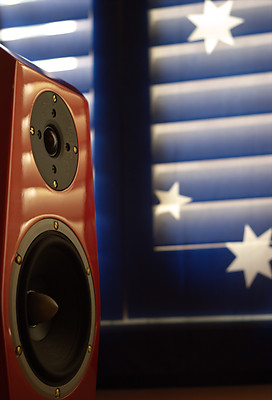
Lenehan Audio ML2 Reference
The source in the Lenehan room was a lovely hand-crafted turntable from Vince Hamilton of Once Analog in Nowra, on the New South Wales South Coast.
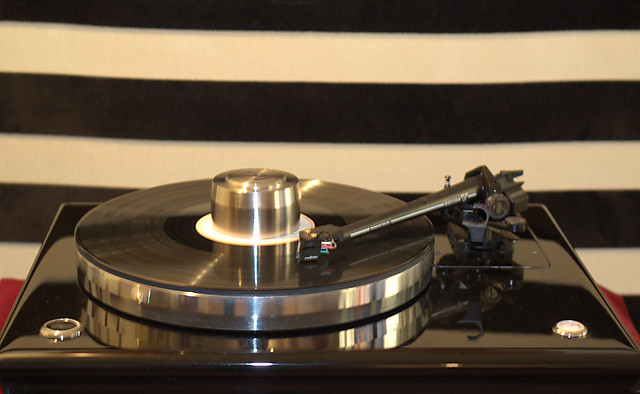
Once Analag
One thing that – I was beginning to realize by now – was that most rooms were very “traditional”: a source – usually a CD player but a number of turntables as well — driving an integrated amp (usually) and a pair of speakers. Other than the Kyron room, I didn’t see as much innovation as I expected – active systems, small systems, networked audio, bass management. Very few rooms had a subwoofer, let alone a swarm of them. I was at least pleased to see this small active sub-sat system from the well-known Richter Acoustics from Sydney’s Northern Beaches area. Priced under a thousand dollars, it should prove a popular recommendation for those seeking something better than a box system but on a limited budget. And it’s red, too.
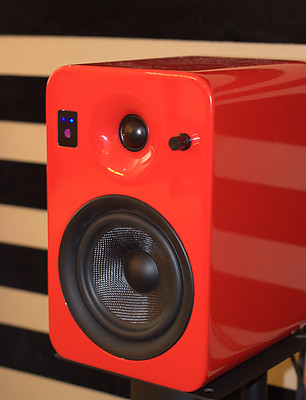
Richter Acoustics sub-sat system
An uncatalogued room that a friend discovered did contain a surprise, though, these curious looking speakers from a new venture, Space Audio, located in Sydney’s South. Very good imaging, although careful room placement would be needed for bass, or the addition of a subwoofer. Available in black, white, and… red.
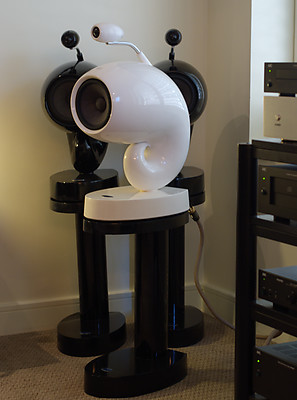
Space Audio
I am undecided whether I preferred rooms that had their own playlists set up and took requests for a style of music, or those that allowed people to play their own CDs. While the latter of course helped me get a consistent marker between rooms, what with the acoustic challenges in the rooms, inadequate setup time, inability (often) to get the sweetspot, and the background chatter, I’m not sure it’s all that important. One downside of allowing people to play their own tracks is that musical tastes are, shall we say, “different.” I heard a couple of “room-clearers” contributed by the audience – they were quite effective too. For all I know, I may have had the same effect on others, as not everybody can fully appreciate the rigorous beauty of the Well-Tempered Klavier.
Perhaps the best that can be done under show conditions is to learn about new products and take note of those that warrant further investigation. To that end, I can’t help but feel that the public price of entry to the show could be reduced, as surely it’s in everybody’s interests to have as many people as possible be exposed to these products – not just the diehard audiophiles but also their friends and family. The popular Rocky Mountain Audio Fest, for example, is only $10 per person for a day, less than half.
But the real standout of the show for me was the ability to meet and talk to the designers and vendors associated with the products. As well as the various Australian speaker makers, I was able to finally meet and chat with Bill McLean of McLean’s Audio on the Central Coast – while it’s only a two-hour drive from me, somehow finding the time to make the trip is hard to do. Bill was running a pair of Magnepan 3.6s from Pure Music on a MacBook Air, driven by a Sanders amp. Included in the signal path was a BSG Qol, which Patrick Dillon reviewed in the last issue of Hifi Zine. Bill’s thoughts on the unit, by the way, were similar to Patrick’s. He also dashed my hopes of seeing the new MMG in Australia very soon. Oh well.
All in all, the Sydney show was a great experience, and I hope the show continues. Hopefully the manufacturers and vendors felt that it was sufficiently beneficial to them to continue to exhibit. I did note that a couple of Australian manufacturers were not present this year, such as SGR Audio. I know that some Melbourne-based concerns felt that the additional cost of travel and accommodation, and the time away from their business, made the Sydney show impractical. Well, here’s to Melbourne (or Brisbane, or any other Australian city) next year – I’ll be booking my tickets for sure!



